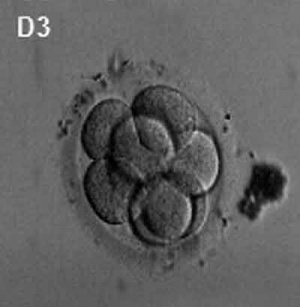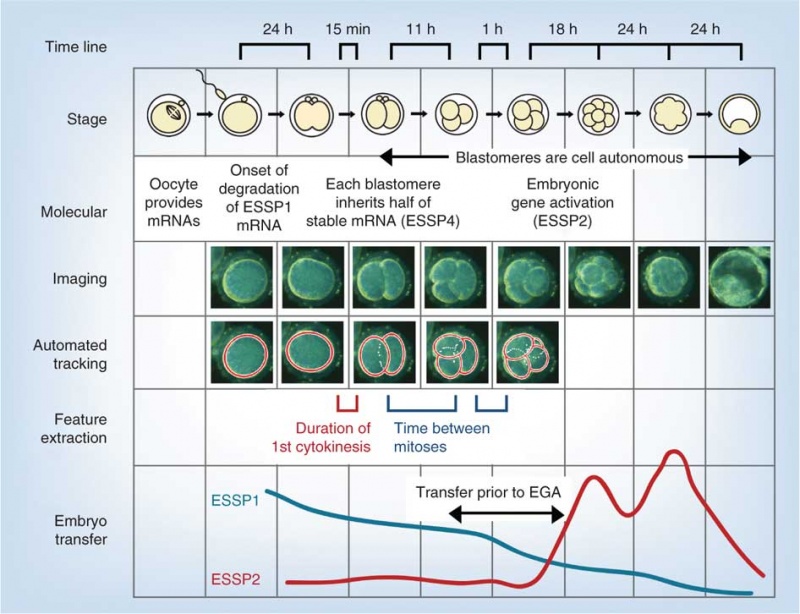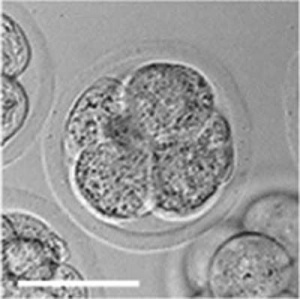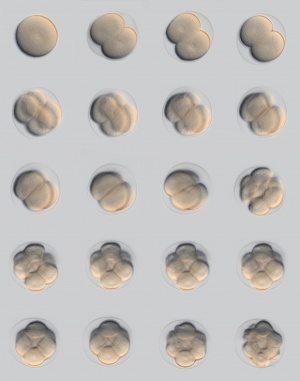Morula: Difference between revisions
No edit summary |
|||
| Line 26: | Line 26: | ||
* E-cadherin mediated adhesion initiates at compaction at the 8-cell stage | * E-cadherin mediated adhesion initiates at compaction at the 8-cell stage | ||
* regulated post-translationally via protein kinase C and other signalling molecules | * regulated post-translationally via protein kinase C and other signalling molecules | ||
==Model Human Morula Development== | |||
The following figure is from a recent study<ref name="PMID20890283"><pubmed>20890283</pubmed>| [http://www.nature.com/nbt/journal/vaop/ncurrent/full/nbt.1686.html Nat Biotechnol.]</ref> using video and genetic analysis of ''in vitro'' human development during week 1 following fertilization. | |||
[[File:Model human blastocyst development.jpg|800px]] | |||
* EGA - embryonic genome activation | |||
* ESSP - embryonic stage–specific pattern, four unique embryonic stage–specific patterns (1-4) | |||
:'''Links:''' [[:File:Model human blastocyst development.jpg|Figure with legend]] | |||
Revision as of 14:04, 4 November 2010
Introduction

(Latin, morula = mulberry) An early stage in post-fertilization development when cells have rapidly mitotically divided to produce a solid mass of cells (12-15 cells) with a "mulberry" appearance. This stage is followed by formation of a cavity in this cellular mass blastocyst stage.
A key event prior to morula formation is "compaction", where the 8 cell embryo undergoes changes in cell morphology and cell-cell adhesion that initiates the formation of this solid ball of cells.
In humans, morula stage of development occurs during the first days of the first week following fertilization. This developmental stage is followed by formation of a cavity, the blastocoel, which defines formation of the blastocyst.
- Links: Fertilization | Week 1 | Morula | Blastocyst
Some Recent Findings

|
Compaction
- E-cadherin mediated adhesion initiates at compaction at the 8-cell stage
- regulated post-translationally via protein kinase C and other signalling molecules
Model Human Morula Development
The following figure is from a recent study[2] using video and genetic analysis of in vitro human development during week 1 following fertilization.
- EGA - embryonic genome activation
- ESSP - embryonic stage–specific pattern, four unique embryonic stage–specific patterns (1-4)
- Links: Figure with legend
Morulas in Other Species
Mouse 4 cell morula stage development[3]
Sea Urchin early embryo cleavage pattern (SDB Gallery Images)
References
- ↑ 1.0 1.1 <pubmed>19924284</pubmed>| PMC2773928 | PLoS One
- ↑ 2.0 2.1 <pubmed>20890283</pubmed>| Nat Biotechnol.
- ↑ <pubmed>20405021</pubmed>| PMC2854157 | PLoS
Articles
<pubmed>19289087</pubmed> <pubmed>20157423</pubmed>
Search PubMed
Search Pubmed: morula development | blastomere development |
Glossary Links
- Glossary: A | B | C | D | E | F | G | H | I | J | K | L | M | N | O | P | Q | R | S | T | U | V | W | X | Y | Z | Numbers | Symbols | Term Link
Cite this page: Hill, M.A. (2024, June 27) Embryology Morula. Retrieved from https://embryology.med.unsw.edu.au/embryology/index.php/Morula
- © Dr Mark Hill 2024, UNSW Embryology ISBN: 978 0 7334 2609 4 - UNSW CRICOS Provider Code No. 00098G


